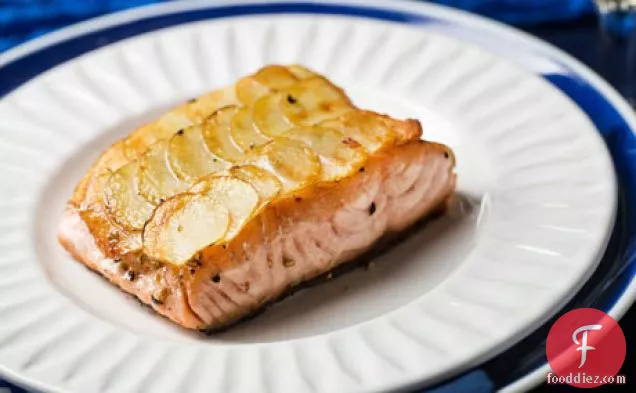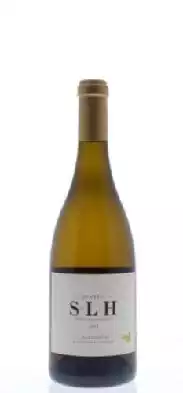Salmon with Potato "Scales"

Need a gluten free, fodmap friendly, and pescatarian main course? Salmon with Potato "Scales" could be an amazing recipe to try. This recipe serves 8. One portion of this dish contains around 46g of protein, 29g of fat, and a total of 498 calories. From preparation to the plate, this recipe takes approximately 2 hours. If you have salt, center-cut salmon fillet, russet potatoes, and a few other ingredients on hand, you can make it. To use up the salt you could follow this main course with the Apple Turnovers Recipe as a dessert.
Instructions
1
Trim 1 to 2 inches off thinner (belly) side of salmon fillets so that remaining fillets have a more even thickness. Reserve the belly strips for another use. You will now have 2 more square-shaped pieces of salmon fillet.
Ingredients you will need![Salmon Fillets]() Salmon Fillets
Salmon Fillets
3
Arrange fish, skin side down, on a baking sheet (or 2 dinner plates). Season with 1 teaspoon each salt and pepper.
Ingredients you will need![Salt And Pepper]() Salt And Pepper
Salt And Pepper![Fish]() Fish
Fish
Equipment you will use![Baking Sheet]() Baking Sheet
Baking Sheet
5
Cut several 1/16-inch-thick slices lengthwise from wider side of 1 potato with slicer (discard outer piece or pieces that are all peel). Stack slices of potato and cut out as many rounds as possible with cookie cutter.
Ingredients you will need![Cookies]() Cookies
Cookies![Potato]() Potato
Potato
Equipment you will use![Cookie Cutter]() Cookie Cutter
Cookie Cutter
6
Dip potato rounds, one at a time, in butter and lay slices on top of one piece of fish in an overlapping pattern (to resemble fish scales), covering surface completely. Continue cutting and stacking a few potato slices at a time and cutting and applying potato "scales" to fish in batches, until tops of all pieces of fish are coated. Lightly brush any remaining butter over scales, and chill until butter is firm, about 1 hour.
Ingredients you will need![Butter]() Butter
Butter![Potato]() Potato
Potato![Fish]() Fish
Fish![Dip]() Dip
Dip
7
Preheat oven to 400°F with rack in middle. Line a large rimmed sheet pan with foil.
Equipment you will use![Aluminum Foil]() Aluminum Foil
Aluminum Foil![Oven]() Oven
Oven![Frying Pan]() Frying Pan
Frying Pan
8
Heat oil in a 12-inch nonstick skillet over medium heat until it shimmers (dip a corner of a fish fillet into skillet to test; it should sizzle).
Ingredients you will need![Fish Fillets]() Fish Fillets
Fish Fillets![Dip]() Dip
Dip![Cooking Oil]() Cooking Oil
Cooking Oil
Equipment you will use![Frying Pan]() Frying Pan
Frying Pan
9
Add 2 to 3 pieces of fish, potato sides down, to skillet. Cook until potatoes are golden brown and crisp, 2 to 4 minutes. Carefully turn fish over using 2 spatulas and cook until skin is golden and crisp, about 2 minutes. Carefully transfer fillets (again using 2 spatulas), skin sides down, to sheet pan. Brown remaining fillets.
Ingredients you will need![Potato]() Potato
Potato![Fish]() Fish
Fish
Equipment you will use![Spatula]() Spatula
Spatula![Frying Pan]() Frying Pan
Frying Pan
10
Roast fish in oven until just cooked through, 4 to 8 minutes (depending on thickness; a possible visual clue—the better quality the salmon, the less likely you'll see it—is when the white albumin in the fish exudes from the fish and begins to set).
Ingredients you will need![Salmon]() Salmon
Salmon![Fish]() Fish
Fish
Equipment you will use![Oven]() Oven
Oven
1
•Fish with "scales" can be prepared (but not cooked) up to 3 hours ahead. Keep chilled, covered with plastic wrap.•:There are varying thoughts on whether it's easier to cook the fish skin side down first or potato side down first. Author Melissa Roberts found it easier to cook it skin side down first, while Gourmet Live staffers leaned towards cooking it potato side down first. Because you are cooking the fish in batches, try both ways and see which works best for you.•A slotted spatula is a pancake turner, whether it's metal or silicone-coated. Turning fish fillets over is even easier with a fish turner or fish spatula, which has more and longer slots than a regular slotted spatula.
Ingredients you will need![Fish]() Fish
Fish![Potato]() Potato
Potato![Wrap]() Wrap
Wrap
Equipment you will use![Plastic Wrap]() Plastic Wrap
Plastic Wrap![Spatula]() Spatula
Spatula
Ingredients
Recommended wine: Chardonnay, Pinot Noir, Sauvignon Blanc
Salmon works really well with Chardonnay, Pinot Noir, and Sauvignon Blanc. To decide on white or red, you should consider your seasoning and sauces. Chardonnay is a great friend to buttery, creamy dishes, while sauvignon blanc can complement herb or citrus-centric dishes. A light-bodied, low-tannin red such as the pinot noir goes great with broiled or grilled salmon. You could try Hahn Winery Santa Lucia Highlands Chardonnay. Reviewers quite like it with a 4.1 out of 5 star rating and a price of about 17 dollars per bottle.

Hahn Winery Santa Lucia Highlands Chardonnay
Rich and layered, with silky notes of peach, nectarine, ripe pear and vanilla.DifficultyExpert
Ready In2 hrs
Servings8
Health Score40
Related recipes
Rosemary-Lemon Roast Chicken
Roasted Turkey, Navy Style
Flavorful Flank Steak
Rosemary-Lemon Roast Chicken
Magazine

Your Inner Chef with Taylor Swift's Top 3 Recipes from Her Beloved NYC Hangout

20 Mouthwatering Recipes You Need to Try Today!

Master the Art of Making Perfect Pancakes with This Foolproof Recipe

The Science Behind Red Wine: Its Surprising Health Benefits and Potential Risks

12 Wine Cocktails for a Sophisticated Twist

Sip, Swirl, and Celebrate: Toasting to National Wine Day on May 25th

National Drink Wine Day on February 18

Celebrating Souffle Day with Delectable Delights

Indulge in the Delightful Flavor of Oyster Soup on Its Special Day!

Celebrating World Nutella Day

Exploring the Delights of Authentic French Pastries

Discover the Flavors of Eastern Europe

Predicted Food Trends for 2023 and Beyond

Exciting Christmas Recipes to Try for the Ultimate Holiday Feast in 2023

Street Food Revolution

Uncover the Secrets of Lip-Smacking Recipes for Outdoor Cooking

Unveiling the Science Behind Cultured Meat

Our Ultimate Recipes Guide for 2023-2024

Australian Cuisine Exploring the Flavors Down Under

From Asado to Empanadas Food Culture Argentina

Your Inner Chef with Taylor Swift's Top 3 Recipes from Her Beloved NYC Hangout

20 Mouthwatering Recipes You Need to Try Today!

Sip, Swirl, and Celebrate: Toasting to National Wine Day on May 25th

National Drink Wine Day on February 18

Indulge in the Delightful Flavor of Oyster Soup on Its Special Day!

These Super Recipes for Your Football Party!

The Secrets Behind 3 Classic Comfort Food Recipes

Recipes to Spice Up Your February Menu

Top 20+ Must-Try Recipes Dominating February 2024














